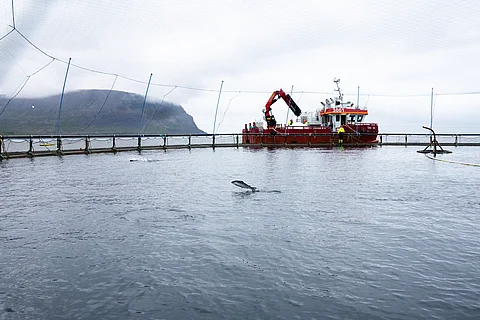

With almost 83% of the total value, it was farmed salmon once again that led to the record growth in aquaculture export value in Iceland in the first nine months of the year.
Photo: Radarinn.
Breaking records seems to be the tone for the value of aquaculture exports in Iceland. It did so in July, did so again in August, and, driven once more by farmed salmon, reached a new record in September with a value of just over ISK 4.6 billion (EUR 30.8 million / USD 33.6 million). This represents an increase of about a quarter - 25% - compared to the same month last year.
As a result of this continuous and sustained growth, in the first nine months of the year, the total export value of Icelandic aquaculture products reached more than ISK 35 billion (EUR 235 million / USD 255.9 million). Compared to the same period 2023, this is an increase of 23% but, in addition, it is also the highest value ever recorded.
Thus, according to data provided by the Icelandic dashboard of the fishing industry and aquaculture, Radarinn, from January to September, the value of aquaculture products represented approximately 14% of the export value of seafood products and 5% of the total value of merchandise exports in the country. These records have also never been higher in the first nine months of the year.
"It should now be clear to everyone that aquaculture has already become a significant component of Iceland's exports and will undoubtedly become even more prominent in the future," Radarinn stated in its analysis. "This development is highly positive, as fish farming increases export diversity and strengthens the country’s foreign currency revenue, with beneficial impacts on employment and communities across the country."
"It is also important to remember that sustained growth in export revenues is a fundamental condition for sustainable economic growth and improved living standards in Iceland," it continued. The insistence is not surprising in a country where, according to a survey published last July, an overwhelming majority of Icelanders - 65.4% - oppose open-net salmon farming compared to only 13.9% who are in favor of marine aquaculture.
In its report last month, the Icelandic dashboard of the fishing industry and aquaculture said that sea-cage farming is the backbone of salmon production in the country and that it is expected to remain so in the coming years. The data on the value of aquaculture exports proves it right since, once again, its upward trend is largely due to salmon farming.
At the end of September, the export value of farmed salmon in the first nine months of the year had reached more than ISK 29 billion (EUR 194.7 million / USD 212.1 million) in Iceland, or almost 83% of the total value. This figure, an increase of 35% over the same period in 2023, is the highest on record for salmon exports.
This upward trend is also found in another species, Senegalese sole, whose export value at the end of September had reached more than ISK 1.3 billion (EUR 8.7 million / USD 9.5 million) for the first nine months of the year. This represents an increase of 78% year-on-year on the same scale for this species which is one of the most valuable food fish in the world.
Against this, weighed down by earthquakes and volcanic activity in Grindavík disrupting some producers' operations, this period saw a considerable decline in the export value of trout, which is predominantly Arctic char. From January to September 2024, it reached ISK 3.3 billion (EUR 22.1 million / USD 24.1 million), a decrease of 21% compared to the same period last year.
Finally, the export value of fertilized salmon eggs - a product that Radarinn describes as "valuable high-tech production" - also recorded a significant decrease, with just over ISK 1.4 billion (EUR 9.4 million / USD 10.2 million) in the first nine months of the year, a decline of 31% compared to the same period in 2023.
